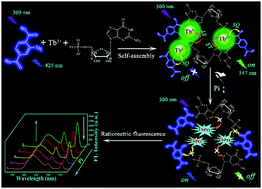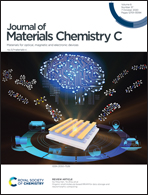A lanthanide coordination polymer as a ratiometric fluorescent probe for rapid and visual sensing of phosphate based on the target-triggered competitive effect†
Abstract
Developing novel luminescent materials for sensitive and rapid detection of phosphate (Pi) is vital in clinical diagnoses and water-quality monitoring. Herein, a lanthanide coordination polymer (NH2-BDC–TbGMP CPs)-based ratiometric fluorescent probe is designed for quick and visual detection of Pi. The NH2-BDC–TbGMP CPs are prepared via the self-assembly of 2-aminoterephthalic acid (NH2-BDC) and guanine monophosphate (GMP) with terbium ions (Tb3+). After the formation of NH2-BDC–TbGMP CPs, the inherent fluorescence of NH2-BDC is quenched via static quenching, while the nonluminous Tb3+ can emit strong green fluorescence due to the antenna effect between Tb3+ and GMP. In the presence of Pi, Pi can competitively combine with Tb3+ to interrupt the interaction of the NH2-BDC–TbGMP CP system, further causing a decrease in the fluorescence of Tb3+ and an increase in the emission of NH2-BDC. Accordingly, the ratiometric fluorescence sensing of Pi can be achieved by continuously recording the variations of two fluorescence signals. The corresponding fluorescence intensity ratio of Tb3+ to NH2-BDC (F547/F425) is linearly correlated with the Pi concentration in the range of 0.5 to 100 μM, with a detection limit of 0.13 μM. This strategy offers a simple, rapid, and sensitive method for the ratiometric fluorescence and visual sensing of Pi, which shows great application potential for water-quality monitoring.



 Please wait while we load your content...
Please wait while we load your content...